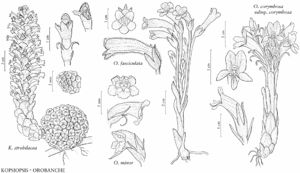Orobanche minor
Engl. Bot. 6: plate 422. 1797.
Plants simple, (8–)12–55(–70) cm, slender, base sometimes abruptly enlarged. Roots usually conspicuous (often forming a globular mass), very slender, usually branched. Leaves several to numerous, loosely ascending to spreading, imbricate only near stem base; blade lanceolate to oblong-ovate or triangular-ovate, 6–20 mm, margins entire, apex acute to acuminate, surfaces moderately to densely glandular-pubescent. Inflorescences spikes, reddish brown to purple or yellow, simple, sparsely to densely glandular-pubescent; flowers numerous, axis visible between flowers; bracts slightly reflexed, narrowly lanceolate, 6–17 mm, apex attenuate, glandular-pubescent. Pedicels 0–0.8 mm (rarely to 30 mm in proximalmost flowers); bracteoles 0. Flowers: calyx yellow or brownish red to brownish purple, strongly bilaterally symmetric, (6–)8–12 mm, deeply divided into 2 lateral lobes (rarely with an additional vestigial abaxial lobe), lobes entire or asymmetrically divided into 2 teeth or short lobes, these much shorter than tube, lanceolate to subulate-attenuate, ± glandular-villous; corolla 10–19 mm, tube white to pale yellow, not or only slightly constricted above ovary, ± curved, glandular-puberulent; palatal folds prominent, yellow to nearly white, usually glabrous; lips similar in color to tube, more commonly purplish tinged and/or veined, sometimes more strongly so externally, abaxial lip spreading abruptly from base, 3–4 mm, lobes broadly ovate to ± semiorbiculate (this sometimes difficult to observe because of the crinkled, erose-crenulate margins and overlapping sinuses), apex rounded or shallowly emarginate, adaxial lip erect or curved outward at tip, 3–5 mm, lobes shallow, ± semiorbiculate, apex broadly rounded; filaments sparsely pubescent, distal hairs gland-tipped, anthers included, glabrous or tomentulose. Capsules ovoid to oblong-ovoid, 5–9 mm. Seeds 0.2–0.4 mm. 2n = 38.
Phenology: Flowering Apr–Jul.
Habitat: Old fields, forest margins, woodland openings, railroad embankments, roadsides, pastures, crop fields, orchards, gardens, lawns, disturbed areas, greenhouses.
Elevation: 0–300 m.
Distribution
Introduced; Del., D.C., Fla., Ga., Idaho, Md., N.J., N.Y., N.C., Oreg., Pa., S.C., Tex., Vt., Va., Wash., W.Va., Eurasia, n Africa
Discussion
Orobanche minor has been documented most frequently parasitizing introduced clovers (mainly Trifolium arvense and T. repens), and collected rarely on Crotalaria (J. W. Thieret 1971) and Vicia. It also has been recorded, at least historically, on a variety of cultivated hosts in the region, including hemp, carrots (Daucus carota), tobacco, geraniums (Pelargonium spp.), and Petunia spp. Allegedly, the species is toxic to livestock (Thieret). The sole specimen from Idaho (J. A. Allen s.n., 1875, NY) lacks locality data; if the provenance is correct, the elevational range would be extended upward.
European authors have recognized a number of infrataxa and segregates; for example, F. J. Rumsey and S. L. Jury (1991) provisionally accepted four varieties of Orobanche minor as occurring in the British Isles. However, they noted that little is known about cytological and morphological variation within the complex. Thus, it seems inappropriate to apply an infraspecific classification to the North American plants.
A single historical specimen (J. C. Nelson 3337, 25 August 1920, GH) collected from ship’s ballast in the Linnton area of Portland, Oregon, is an unusually stout plant with apparently pale corollas and filaments relatively densely pubescent toward their bases. This plant may represent a record of Orobanche loricata Reichenbach, a European species that parasitizes mainly Picris and other Asteraceae, and does not affect any crop plants. However, specimen condition precludes definitive determination, and the label does not list a host species. Other materials from Oregon have the typical morphology of O. minor.
Selected References
None.
